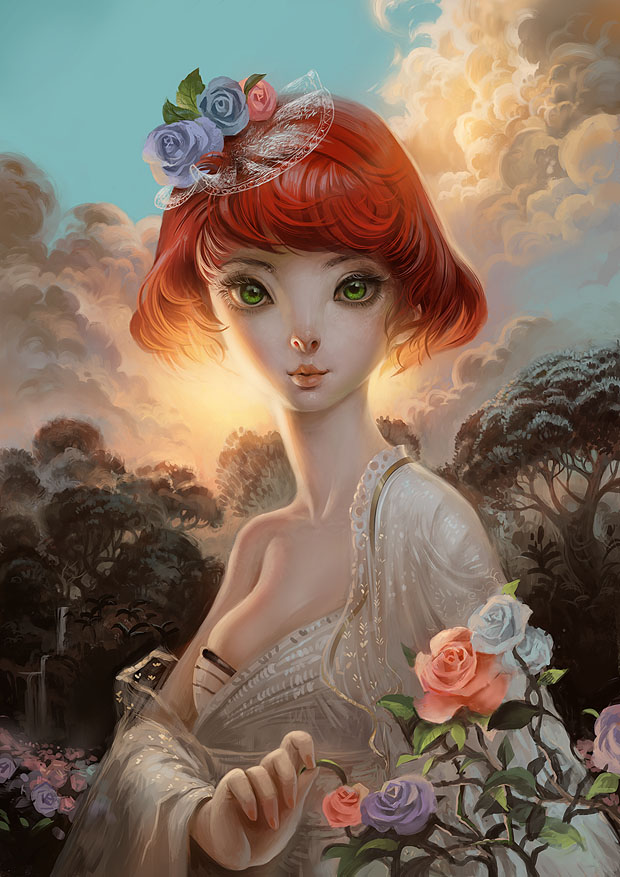Digital Painting:
Digital
painting is artwork created digitally or through the use of art software on a computer. Digital art programs
bring a huge range of artistic materials right at your finger tips.
Although there is a clear distinction between traditionally made and
digitally made artwork, digital artwork allows you to emulate and adapt
traditional mediums by using a virtual canvas and tool box of colors, brushes and various unique artistic effects.
Tools:
It
is essential that you have an art program to create digital artwork (
see Painting Software for more information) and a tool used to draw. You could use a regular mouse but a drawing tablet and pen is much preferred and is meant for creating digital artwork.
* Drawing Tablet + Pen/Stylus:
Prices range from around $40 to a couple thousand for higher end models. The average price is usually around $60-$90 and often they come with a trial of an art program. A recommended and trusted brand is Wacom tablets, such as http://www.amazon.com/Wacom-Intuos-Small-Tablet-CTL480/dp/B00EN27TCI/ref=dp_ob_title_ce
* Mouse:
Much more difficult to use but easily available and convenient to start with.
*Scanner/ Camera (optional):
If you want to incorporate traditional artwork and then work on it digitally, you may want to invest in a quality image scanner or camera.
Drawing + Painting Software:
There
is a fairy wide range of art programs to create digital artwork with.
The most basic and one you've probably used is MS Paint. It is a
simple program which offers you basic functions. Then there programs
such as Photoshop which offer a much wider range of quality functions and
options. Don't worry if you can't afford a program like Photoshop,
there are programs (while a bit limited in some regards) that are still comparable to
many paid programs. Here is a quick list of some popular programs:
* Photoshop
* Corel Painter
* Adobe Illustrator
* Krita ( free) krita.org/download
* Krita ( free) krita.org/download
* Gimp (free) http://www.gimp.org/
* Paint.net (free) http://www.getpaint.net/
Getting Started:
It
is suggested that you play around with various art programs until you
find one that suits you. Although they all offer the same basic options, there can be some differences in the way they handle. Don't
worry about figuring out every little function of the program, these
programs can easily become too complicated with the various effects and
options that are included, especially for someone who is new to it.
Start small and get down the basics of the program, primarily the basic
tool selection box such as your color
palette, brush options, and image tools.
Basic window with an open canvas , tool selection on right. (Gimp)
* Like with any other drawing material, practice makes perfect.
* Like with any other drawing material, practice makes perfect.
* There are plenty of tutorials online for any given art program, so finding help is quick and easy. Here are a few to look at.
- http://ctrlpaint.com/library/
- http://www.deviantart.com/?q=digital+painting+tutorial
- http://creativerepository.com/2010/03/14/40-excellent-and-breathtaking-digital-painting-tutorials/
- http://ctrlpaint.com/library/
- http://www.deviantart.com/?q=digital+painting+tutorial
- http://creativerepository.com/2010/03/14/40-excellent-and-breathtaking-digital-painting-tutorials/
*
One of the most important things to learn is the use of layers. Layers
are very important to digital artwork, here is a simple
tutorial/walkthrough on how layers are used within a piece.
-http://www.wikihow.com/Use-Layers-for-Digital-Art
- http://lifehacker.com/5780767/digital-painting-101-lesson-4-layers
While traditional paintings have there own system of layers (wash layer, color blocking, under painting, etc.), layers in a digital image allow you to separate aspects of your image without having to worry about messing up other parts.
-http://www.wikihow.com/Use-Layers-for-Digital-Art
- http://lifehacker.com/5780767/digital-painting-101-lesson-4-layers
While traditional paintings have there own system of layers (wash layer, color blocking, under painting, etc.), layers in a digital image allow you to separate aspects of your image without having to worry about messing up other parts.
* Uses?
If you're not sure about jumping into digital art then here are some suggestions on how you can use it to get started.
If you're not sure about jumping into digital art then here are some suggestions on how you can use it to get started.
* traditional to digital
- many artists will start with a traditional piece of work and then digitally color the image or rework it.
* rough drafts ( digital to traditional)
-
many artists start with a rough draft of their work and then work and
refine it from there. You can work out a simple rough draft digitally, to get a sense to a color palette or composition then use it
as a guide when working on a
traditional painting.
Why
chose Digital Painting?
Digital
painting allows the user to experience many mediums of art all in one
simple and convenient place. Use it as a sketch journal for quick pencil/sketch studies or for more refined paintings. Explore painting with the aesthetics of oils, watercolor, acrylic and more. Experiment with color palettes and painting tools easily. You don't have to worry about running out of materials, creating a mess, or carrying all your supplies with you.
Examples:
http://euclase.deviantart.com/


Examples:
http://euclase.deviantart.com/












No comments:
Post a Comment